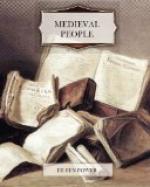lofty hall, or climbing upon his dresser to find the
head, as small as a walnut, hidden in the carving of
the ceiling, were his nephews and nieces, Robert and
Margaret Uppcher, his sister’s children; John,
the son of his brother John; and Thomas, Robert, and
Emma, the children of his brother Robert; perhaps also
his little godchild Grace Goodday. It was perhaps
in the hope of a son to whom he might leave his house
and name that Thomas Paycocke married again a girl
called Ann Cotton. She was the wife of his old
age, ‘Anne my good wif’, and her presence
must have made bright the beautiful house, silent and
lonely since Margaret died. Her father, George
Cotton, is mentioned in the will, and her brothers
and sister, Richard, William, and Eleanor, have substantial
legacies. But Thomas and Ann enjoyed only a short
term of married life; she brought him his only child,
but death overtook him before it was born. In
his will he provides carefully for Ann; she is to
have five hundred marks sterling, and as long as she
lives the beautiful house is to be hers; for to his
elaborate arrangements for its inheritance he adds,
’provided alwey that my wif Ann haue my house
that I dwell in while she lyvyth at hir pleyser and
my dof house [dove-house] with the garden y’t
stoundeth in.’ A gap in the Paycocke records
makes it difficult to say whether Thomas Paycocke’s
child lived or died; but it seems probable that it
either died or was a girl, for Paycocke had bequeathed
the house, provided that he had no male heirs, to his
nephew John (son of his eldest brother John), and
in 1575 we find it in the hands of this John Paycocke,
while the house next door was in the hands of another
Thomas Paycocke, his brother Robert’s son.
This Thomas died about 1580, leaving only daughters,
and after him, in 1584, died John Paycocke, sadly
commemorated in the parish register as ’the last
of his name in Coxall’. So the beautiful
house passed out of the hands of the great family
of clothiers who had held it for nearly a hundred
years.[12]
Of Thomas Paycocke’s personal character it is
also possible to divine something from his will.
He was obviously a kind and benevolent employer, as
his thought for his work-people and their children
shows. He was often asked to stand godfather
to the babies of Coggeshall, for in his will he directs
that at his burial and the ceremonies which were repeated
on the seventh day and ‘month mind’ after
it there were to be ’xxiiij or xij smale childryn
in Rochettes with tapers in theire hands and as many
as may be of them lett them be my god childryn and
they to have vj s. viij d. apece and euery oder child
iiij d. apece ... and also euery god chyld besyde
vj s. viij d. apece.’ All these children
were probably little bread-winners, employed at a
very early age in sorting Thomas Paycocke’s
wool. ‘Poore people,’ says Thomas
Deloney, ’whom God lightly blessed with most
children, did by meanes of this occupation so order
them, that by the time they were come to be sixe or




